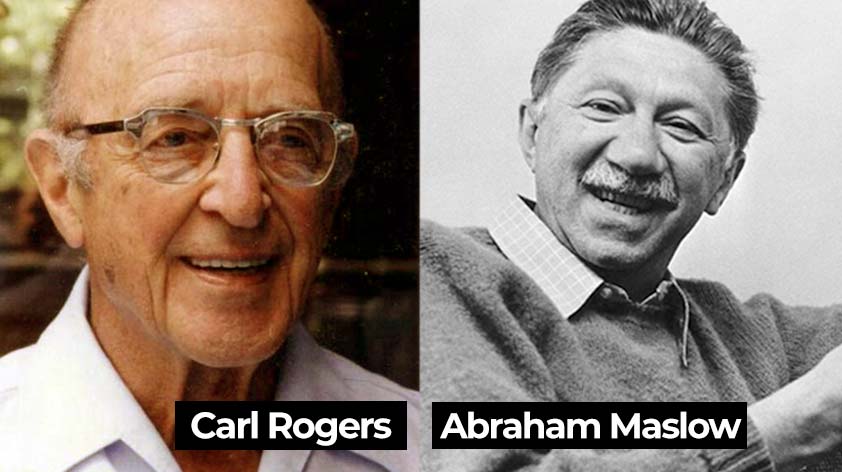
“Love is the bridge between you and everyone else.” ― Abhijit Naskar. In this article, we’re going to talk about the “humanistic” approach to psychology and theory, based on the works and ideas of experts, Carl Rogers (American psychologist and among the founders of the humanistic approach in psychology), and Abraham Maslow (American psychologist who created Maslow’s hierarchy of needs). So, let’s jump into Humanistic Psychology: Maslow & Rogers – A Closer Look!
What is “Humanism”?
It first appeared in the USA in 1961 with the founding of the American Association for Humanistic Psychology (AAHP). It began by rejecting the repression posed by psychoanalysis along with the rigidity of behaviourism.
After going through two world wars, the world needed a new approach, a freer approach. Because of this, he was quickly accepted. In humanistic psychology, the theory is that man is free, and by default of a good nature, his focus is subjective, and he is seen as a whole person, to be accepted as he is.
Humanistic psychology greatly empowered man, and brought a new point of view whilst removing many prejudices about psychology and therapy; people went to therapy to be, and get better and to give themselves a shot at a better future.
Limitations
- It ignores biological determinants
- It has very few objective concepts, which makes it difficult to prove scientifically
Abraham Maslow
Born in 1901 in Brooklyn, New York, Abraham was the first of seven children of Jewish parents who emigrated from Russia, he described his childhood as sad and lonely, spending much of his time in the library just reading.
He started out studying law, and later developed an interest in psychology and went on to finish his studies at the University of Wisconsin.
During the 1950’s he became one of the founders of humanistic psychology theory, and among his influences Gestalt psychology was predominant.
This theory diverged from psychoanalysis and behaviourism because it focused on people more positively, and looked to the future instead of the past. In this way, the creative potential of people could be constructively (in a good way) exploited.
His Contributions
The best known is Maslow’s pyramid (see below) or hierarchy of human needs, which proposes five levels that must be satisfied to reach self-realization. To move from one level to another, we must first have a “covered” need, which means that it must be within the person’s reach.
Another concept to consider is that not everyone reaches the last level, some people stagnate at lower levels, thus never reaching their full potential. When we talk about self-actualization, we are not referring to a specific activity, this is different for each individual. Finally, it is worth saying that this is not an “objective” but a “process”.
People who completed the process have characteristics that make them stand out from the rest, such as the following:
- They are very creative
- Possess an unusual sense of humour
- Able to have deep friendships with people
- They need privacy
- They appreciate the finer details of life
- Possess strong moral and ethical standards
Some attitudes that will help us to follow this path include:
- Trying new things and not getting stuck with the same thing
- Be prepared to be alone when your point of view is not the most popular
- Take responsibility and work hard
- Live new experiences as a child would
Finally, some of his most important contributions to psychology were the following:
- A new approach to the positive side of human nature
- His work influenced how we view mental health
- His works are still of paramount importance today, despite criticism about the antiquity of those necessities
Carl Rogers
Carl Ransom Rogers was born in 1902 in Oak Hill, Illinois. In 1919 he began to study at the University of Wisconsin, after several changes in his profession, he graduated in 1931 as a clinical psychologist at Columbia University.
Rogers developed a therapy approach called ‘non-direct therapy’, which relies on the psychologist being a facilitator rather than the director of the session. This later came to be called “client-centred therapy.”
Rogers agreed with Maslow and his approach, however, he added that for the person to “grow” they need a context-environment that empowers them and eases their growth, acceptance and empathy.
He believed that anyone could achieve their desires and goals in life, thereby achieving self-fulfilment. Like Maslow, Rogers rejected the nature of psychoanalysis and behaviourism, because we act according to our beliefs and how we perceive a given situation.
Some of His Most Important Contributions
Self-actualization. We all tend to improve and reach for our potential (contrary to psychoanalysis). Congruence. In a nutshell, this refers to situations when our ideal self does not match our self at a particular moment when we do not follow our values. In this scenario we are not the person we want to be.
Rogers characterized a fully functional person as:
- Flexible and creative
- Open to new experiences
- Ability to live in peace with others.
- Unconditional consideration for oneself
With his emphasis on human potential, Rogers was highly influential in psychology and education.
Conclusion
- As we can see, this type of psychology refused to follow the same path as the other theories and created a completely different approach
- It is true that sometimes it seems illogical by being subjective and poetic, but sometimes life is about that, finding the beauty in the ‘ugly‘
- As its name suggests, this approach makes us more human, it allows us to see and frame the future in a positive way
What do you think of the works of Abraham Maslow and Carl Rogers? Which of their insights has helped you fulfil your potential best? Let us know in the comments below!









